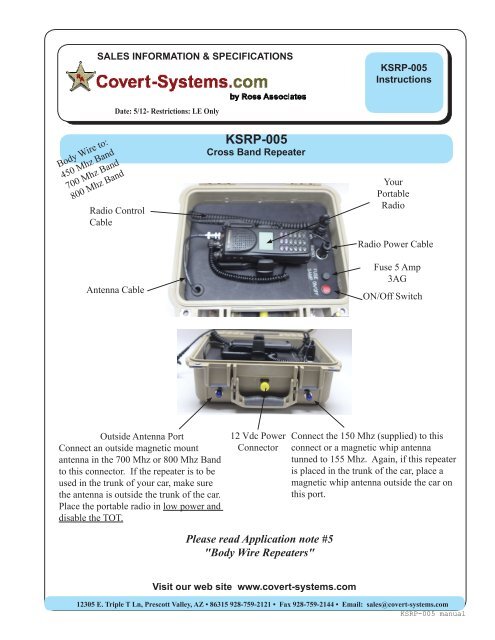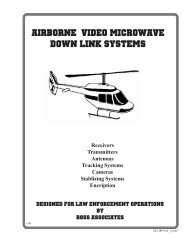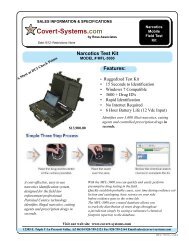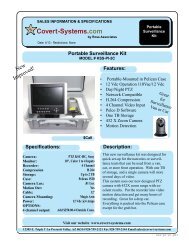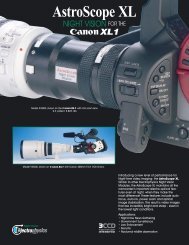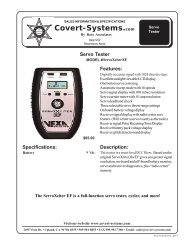KSRP-005 manual.pdf - Covert Systems
KSRP-005 manual.pdf - Covert Systems
KSRP-005 manual.pdf - Covert Systems
You also want an ePaper? Increase the reach of your titles
YUMPU automatically turns print PDFs into web optimized ePapers that Google loves.
SALES INFORMATION & SPECIFICATIONS<strong>KSRP</strong>-<strong>005</strong>InstructionsDate: 5/12- Restrictions: LE OnlyBody Wire to:450 Mhz Band700 Mhz Band800 Mhz BandRadio ControlCableAntenna Cable<strong>KSRP</strong>-<strong>005</strong>Cross Band RepeaterYourPortableRadioRadio Power CableFuse 5 Amp3AGON/Off SwitchOutside Antenna PortConnect an outside magnetic mountantenna in the 700 Mhz or 800 Mhz Bandto this connector. If the repeater is to beused in the trunk of your car, make surethe antenna is outside the trunk of the car.Place the portable radio in low power anddisable the TOT.12 Vdc PowerConnectorConnect the 150 Mhz (supplied) to thisconnect or a magnetic whip antennatunned to 155 Mhz. Again, if this repeateris placed in the trunk of the car, place amagnetic whip antenna outside the car onthis port.Please read Application note #5"Body Wire Repeaters"Visit our web site www.covert-systems.com12305 E. Triple T Ln, Prescott Valley, AZ • 86315 928-759-2121 • Fax 928-759-2144 • Email: sales@covert-systems.com<strong>KSRP</strong>-<strong>005</strong> <strong>manual</strong>
Important Notes:Your portable1) First make sure that you have placed the portable on low power and on the correct frequency.2) Disable the Time Out Timer (TOT)3) Connect an 800 or 700 Mhz antenna to the Outside Antenna Port (Supplied)4) Connect the rubber duck antenna or gain antenna to the right hand connector.5 Connect the power cable to the power connector and turn on the unit. Make sure your portableradio is tuned on also.6) The input and output antennas seperated by 3 feet plus to minimise receiver desense.7) Make sure that your radio tech knows how you are using the channel8) there is a portable release button on the side of the radio cradle. Use this button to release yourradio and insert the radio.Your input or body wire frequency is_____________________________________________NOTES:
Ron’s Application NotesElectronic Surveillance Made EasyStep by StepApplication: Body Wire Repeaters Application # 5 Date: Jan 2012Submitted By: StaffSecurity Level: NoneBody wire repeaters can be broken into 2 categories. First the standard in-band repeater. Here therepeater takes in a frequency that is repeated out a few megahertz away from the incoming frequency.That is, if your tactical frequency is, lets say, 154.000 Mhz, then they output of the in-band repeatermust be 4 to 5 Mhz higher or lower than the input frequency. So, the typical in-band repeater wouldbe on 159.000 Mhz. The typical separation is normally 5 Mhz. This allows the repeater to operatewithout interfering with its self.I am asked many times over the years, why the separation? And why 5 Mhz? The answer is simple.As I mentioned above, the input frequency must be 5 Mhz up or down from the output frequencyso that there is not an interference between the two frequencies. Now, the second reason why weneed the separation is because the repeater requires a duplexer in the repeater for the unit to operateproperly. The duplexer is a device that keeps the two frequencies seperated in the repeater. It is amechanical device that is tuned to the input and output frequencies. If you understand all that I haveexplained, you are way ahead of the game.Now the cross band repeater. Here the repeater receives your body wire signal and repeats it our ona out of band frequency. Lets say your wire is on 154.000 Mhz and your department is on one of thenew 800 Mhz systems. So, the cross band repeater will receive your wire signal on 154.000 Mhz andrepeat it out on one of your talk around mobile to mobile frequencies on 800 Mhz. Easy huh?? Generallyyes, but you must get your radio tech involved. He in turn, will disable the portable radio’s Timeout-timer(TOT) and put the portable on a mobile to mobile frequency. This will allow your team tolisten in on the wire signal and keep the UC or CI safe. Normally, one does not use the repeater 800frequencies for an operation using wires. If you chose to use an 800 Mhz repeater frequency, theTOT’s must be disabled in the repeaters involved in the operation. Your radio tech will go bananas.Things to do and not do testing your repeater.First, connect your input and output antennas. A dummy load on the output of the repeater is recommendedfor testing purposes. Connect the 12 Vdc cable. DO NOT remove the output antenna whilethe repeater is on. Turn on your receiver and set it on frequency. Turn on your wire and check out thesystem on a local bases. It is always good to check out your installation in simulated operation, thatis, check your range!Installation of the repeater and antennas.I think the largest problem with repeater is antenna placement. With an in-band repeater you onlyneed one antenna. (That is another job that the duplexer does) This antenna can be placed almostanywhere. Of course, the best place is a magnet mount on the trunk of the car. Window mount antennasare also available. With advent of plastic bumpers on the new cars, one can place an 800 Mhzmagnetic mound antenna in the car frame work right next to the bumper and generally cover the localteam with good coverage.<strong>Covert</strong> <strong>Systems</strong>, LLC 12305 E. Triple T. Ln Prescott Valley AZ 86315sales@covert-systems.com 928-759-2121 Fax 928-759-2144


